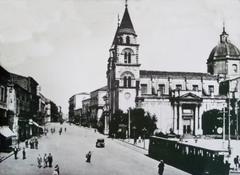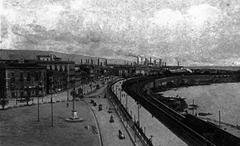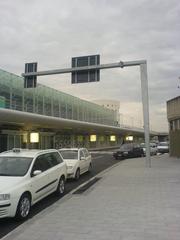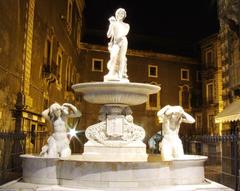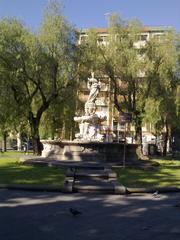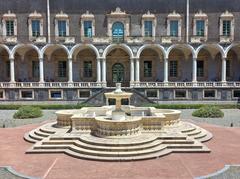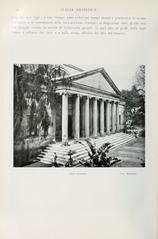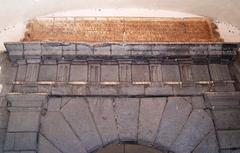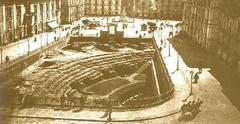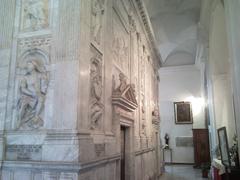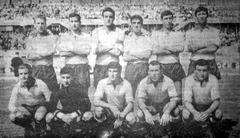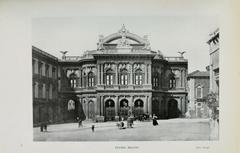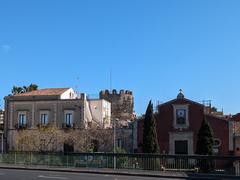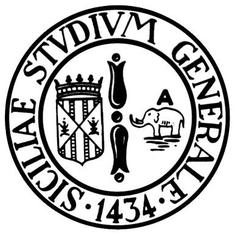Foro Romano di Catania: Visiting Hours, Tickets, and Comprehensive Guide to Catania Historical Sites
Date: 04/07/2025
Introduction
Nestled in the heart of Catania, Sicily, the Foro Romano di Catania is a remarkable archaeological site that offers a vivid window into the city’s ancient Roman heritage. Dating back to when Catania—then known as Catina—flourished under Roman imperial rule, the forum stands as a testament to the layered history and resilience of the city. This guide provides everything you need to know for a memorable visit: from the forum’s historical and architectural significance to practical details like visiting hours, tickets, accessibility, and nearby attractions.
Whether you are an archaeology enthusiast, cultural traveler, or simply curious about Catania’s rich past, this resource will help you plan a rewarding exploration of one of Sicily’s most captivating historical sites. For the latest updates, consult the Polo Museale di Catania, Italia.it, and Sicily Visitor.
Contents
- Introduction
- Historical Overview
- Architectural Features & Urban Context
- Site Layout and Archaeological Remains
- Visiting Information: Hours, Tickets, Accessibility
- Travel Tips & Nearby Attractions
- Conservation and Preservation Efforts
- Visuals and Virtual Resources
- Frequently Asked Questions (FAQ)
- Conclusion & Final Recommendations
- Sources
Historical Overview
Catania’s origins trace back to early Greek settlements in the 8th century BCE, but the city’s transformation under Roman rule was pivotal. As a “Civitas decumana” within the Roman province of Sicilia, Catania underwent significant urban development, including the construction of grand structures like the Foro Romano (facts.net, zainoo.com). The forum served as the civic, commercial, and religious center of ancient Catina, epitomizing Roman urban planning with its central location and integration with other key monuments such as the Roman Theatre and Odeon (wikiwand.com).
Architectural Features & Urban Context
Location and Setting
The remains of the Foro Romano are situated in the historic center of Catania, specifically in the area known as Cortile San Pantaleone, between Via Vittorio Emanuele II and Via Garibaldi (catania.italiani.it). Surrounded by modern buildings, the site is both protected and partially obscured, making it a hidden gem among the city’s many historical attractions.
Construction Techniques
The forum showcases Roman ingenuity with its use of local black lava stone in opus incertum and opus reticulatum masonry styles (catania.italiani.it). The walls, vaulted ceilings, and stone architraves highlight the advanced engineering and distinctive aesthetics of the period. The use of volcanic stone ties the site visually and materially to the landscape shaped by Mount Etna.
Site Layout and Archaeological Remains
Archaeological investigations and Renaissance-era chronicles indicate that the forum complex included a central courtyard surrounded by rooms—likely serving as shops, warehouses (horrea), and administrative offices. Descriptions note eight rooms to the south, four to the north, and additional rooms to the east and west, all featuring vaulted ceilings (catania.italiani.it). Some scholars have identified possible bath complexes (Terme Amasene) and even argued alternative uses for the subterranean rooms, such as for storage or as prison-like ergastula.
Today, parts of the forum are visible from public spaces, particularly two rooms on the southern side and segments of wall in opus reticulatum. Much of the structure is incorporated into modern buildings, with only select areas accessible to visitors (historyof.eu).
Visiting Information: Hours, Tickets, Accessibility
Visiting Hours
- Typical Hours: 9:00 AM to 6:00 PM or 7:00 PM (depending on the season), Tuesday through Sunday.
- Last Entry: Usually 30 minutes before closing.
- Note: Hours may vary seasonally or due to special events. Always check official sources before your visit (Polo Museale di Catania).
Tickets
- Standard Admission: Approximately €6 for adults.
- Discounts: Available for students, seniors, and children.
- Combined Tickets: Often available for entry to both the Roman Theatre and Odeon.
- Guided Tours: Can be booked through the museum or visitor center; guided experiences are highly recommended for deeper insights.
Accessibility
- Mobility: Some areas are accessible to visitors with limited mobility, but uneven ancient terrain and steps may pose challenges.
- Assistance: Contact the museum in advance for specific accommodations.
Travel Tips & Nearby Attractions
How to Get There
- Location: Cortile San Pantaleone, 10, Catania.
- Transport: Reachable by Trenitalia trains (Catania Centrale), city buses (AMT, AST, Etnatrasporti), and Circumetnea railway. Parking and taxi services are available.
What to See Nearby
- Roman Theatre (Teatro Romano): 2nd century BC theatre, a highlight of ancient Catania (The Crazy Tourist).
- Odeon: Smaller venue for music and council meetings, adjacent to the theatre.
- Roman Amphitheater: One of the largest in Italy (italyscapes.com).
- Baroque Piazza Duomo and Catania Cathedral: UNESCO World Heritage landmarks.
- Castello Ursino and Benedictine Monastery: Medieval and Baroque highlights.
Visitor Tips
- Best Time: Early morning or late afternoon to avoid crowds and heat.
- Footwear: Wear sturdy shoes for uneven surfaces.
- Amenities: Restrooms and gift shop near the entrance; dining options nearby.
- Photography: Allowed; inquire about tripod use.
Conservation and Preservation Efforts
The forum’s preservation is challenged by its integration into the dense urban fabric and exposure to environmental risks. Ongoing archaeological research, documentation, and conservation initiatives are in place to protect and interpret the remains for the public and scholars (catania.italiani.it). Community engagement and educational programs, often run in collaboration with local universities and museums, play a vital role in sustaining the forum’s future (Italia.it).
Visuals and Virtual Resources
High-quality photographs, interactive maps, and virtual tours are available on official tourism and cultural heritage platforms. These resources offer a closer look at the site’s architectural features—such as the vaulted rooms and lava stone walls—and are enhanced with descriptive alt text for accessibility and SEO.
Frequently Asked Questions (FAQ)
Q: What are the Foro Romano di Catania visiting hours?
A: Generally open from 9:00 AM to 6:00 PM or 7:00 PM, Tuesday through Sunday. Always confirm on official platforms before your visit.
Q: How much do tickets cost?
A: Standard admission is about €6, with discounts for eligible visitors. Combined tickets and guided tours are available.
Q: Is the site accessible for people with disabilities?
A: Partial accessibility is provided, but some areas may be difficult to navigate due to ancient terrain. Contact the site in advance for arrangements.
Q: Are guided tours available in English?
A: Yes, though Italian tours are more frequent. Check availability and book in advance.
Q: Can I visit both the Roman Theatre and Odeon with one ticket?
A: Yes, combined tickets are commonly offered.
Conclusion & Final Recommendations
The Foro Romano di Catania is a unique destination that encapsulates the grandeur of ancient Rome within the vibrant context of modern Catania. Its evocative remains—vaulted rooms, black lava stone masonry, and colonnaded spaces—invite you to explore two millennia of history. Combined with nearby Roman and Baroque landmarks, a visit to the forum offers a comprehensive and enriching experience of Sicily’s cultural heritage.
Plan your visit by checking the latest hours and ticket information, considering a guided tour for deeper context, and exploring adjacent attractions for a fuller appreciation of Catania’s historical tapestry. For virtual resources, conservation updates, and exclusive travel tips, download the Audiala app and follow us on social media.
Sources
- facts.net
- zainoo.com
- buonastrada.eu
- wikiwand.com
- catania.italiani.it
- historyof.eu
- Italia.it
- Sicily Visitor
- Great Sicily
- Life Part 2 and Beyond
- Sicily Tourist
- The Crazy Tourist
- Eternal Arrival
- Voyage Tips
- WhichMuseum
